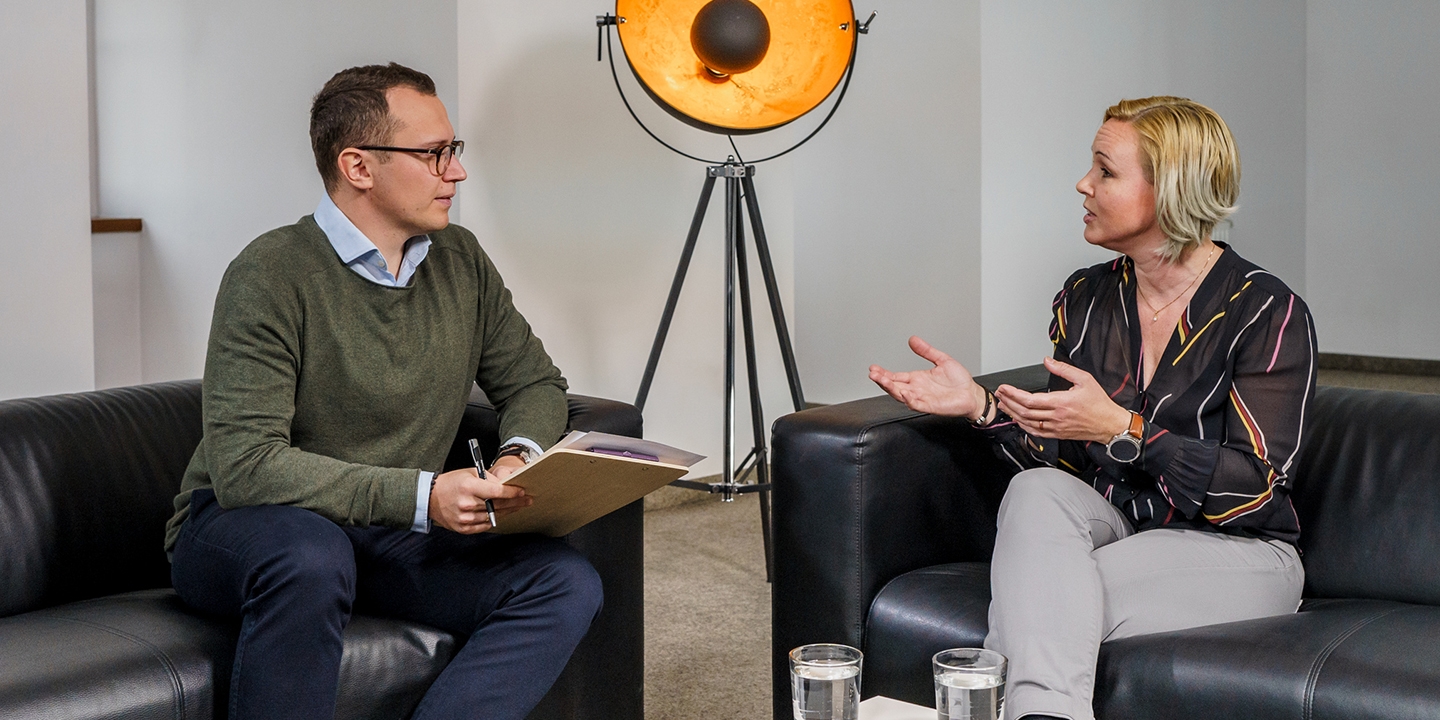- Insights hub
- /
- The future of Smart Mobil...

The future of Smart Mobility with Tamy Ribeiro
- DetailsAbout the talks
- TranscriptTranscript
The future of Smart Mobility with Tamy Ribeiro
Michał Grela
Relationship Manager at Future Processing
Technology is already broadly used to help cities and businesses develop sustainable mobility solutions. But smart mobility is about more than just bringing people to their destinations in a quicker, safer and a more sustainable manner.
It’s a trend that can (and should!) potentially disrupt the way we ‘use’ cities and force us to rethink crucial aspects of our daily lifes.
Michał Grel (MG): Hello, and welcome to another episode of IT Leadership Insights by Future Processing. Today my guest is Tamy Ribeiro and we’re going to focus on smart mobility. Technology is already broadly used to help cities and businesses to develop sustainable mobility solutions but smart mobility is about more than just bringing people to the destination in a quicker, safer and in a more sustainable way is a trend that can and I believe it should potentially disrupt the way we use cities and force us to rethink the most crucial aspects of our daily lives. And a very interesting topic for a conversation definitely. I’m really looking forward to discussing it with my guest today, Tamy. Would you be so kind and introduce yourself and share a few words on your background in the company, please?
Tamy Ribeiro (TR): Yeah, sure. Absolutely. So thank you, Michelle for the invitation. It is great to be here today. My name’s Tamy Ribeiro, I’m and the Chief Mobility Evangelist and head of partnerships of Wunder Mobility, a tech mobility company considered today the fastest growing mobility tech company in Europe. We are currently operating in over 100 cities, six continents offering over 100,000 vehicles road ride. My background is actually in travel. I come from the travel industry where I worked for around 16 years, had the chance to found my company and really get into the topic and see the transition from the book in which you had all the options of hotels and fries to the online version with the pulling system that today everyone can see available. It was a great experience. Five years ago, I moved to Germany because I have two kids and I wanted to actually have a better life quality, allowed them to ride their bikes.
This was actually a dream for me to allow my kids to ride their bikes and go to their friend’s house by themselves, go to school by themselves. And I remember that when I moved to Germany, I could see some kids with six, seven years old walking to school. And I was asking myself, should I call the police? This is crazy. Coming from Brazil, for me, it was like, oh, insane and after one or two years, I got used to it. And I said, “Wow, that’s exactly what I needed.” And so I joined Wunder after seven months. They’re still in German and I’m still there and could see the transition from a B to C carpooling app that was operating in emerging markets to the well known, amazing B2B company offering mobility white label solutions to cities startups and corporates around the world. So that’s where I am today.
MG: Amazing. Wonderful. That’s a really interesting story. I’m happy that Europe met your expectations.
TR: Absolutely.
MG: Let’s give it that way. Let’s jump right into our conversation. Smart mobility. I just wonder, what’s your take on… What are your thoughts on the current state of art when it comes to cities implementing smart mobility solutions because my understanding or I guess the general understanding is that, there’s plenty of vibe and chitchat around it but when it comes to actual use of it, where are we when it comes to actual use of it? I mean, how would you rate the scale of evolution of implementation when it comes to smart mobility solutions in the cities worldwide? Are we there yet?
TR: Yeah. No, we are not. I don’t think so. I think that… So if you stop to think about how it was a few years ago, we had two options. We had public transportation or private vehicles, right? And usually we would go to public transportation if our experience commuting was a seamless one and private vehicles if we were really willing to spend more to have more comfort. Suddenly four years ago, we start to see electric scooters all around. We start to see acts for everything. And what happens is that people see sense in general, they started to push cities to say that they were willing to have this kind of service. So some cities that said no initially, they had to accept after a while that citizens were pushing to the direction in which they wanted to have new technologies. They wanted to try this new mobility concepts.
So the accepted was the case of Germany that just accepted in the last summer. We had the UK as well that accepted a few months ago, micro mobility operators. So super cool but still, it is a slow process if you consider that cities are a really… I would say that it’s the main stakeholder in this process. They are the decision makers but they are really slow. And it’s not because the employees are not willing to see this change happening, it is because it is not like a company that they approve a budget, they sign the contract and they do it right away. They are using public money and they need to justify it. They have all the eyes on them on what they are doing, how they are spending. So it is a longer process and the things that city sometimes don’t follow the speed of innovation, right?
So at the same time, especially for mobility now that we are seeing that in the last three, four years we are seeing so many new concepts launching all around the world. And then Europe, I would say that we do have some cities there, right? A great example we have, for example, Ontivo up in Belgium, we have Helsinki, we have Berlin. We have so many cities that are trying to partner with tech providers that can accelerate this transition to new mobility and accepted that they will not be able to decrease the number of cars if they keep insisting on having the same public transportation with old buses that just come sometimes for people that are living in suburbs and rural areas. Sometimes they just have access every one hour or so and don’t have access to buses in the weekends. So for those, it is not possible.
So it’s time to understand that it’s important to create an ecosystem in which private operators can also join, can also be part of it too, attends the demands that governments are not yet being able to do so. Because afterwards, the main goal is to create a seamless mobility service that will impact the way how people move from A to B and make them leave their cars at home. Because traffic congestion is increasing a lot. It’s terrible in several cities around the road. And if we don’t take a decision today, right now, if cities don’t start to adapt now and find these partners to make people adopt new mobility service, it’s going to be a mess soon.
MG: Really good point. I also agree with what you said regarding the exclusion when it comes to transport, especially affecting the smaller cities. I guess that’s a struggle every country deals with. Also when I was traveling, when that was allowed, I also noticed how there’s different approach to being smart in different cities. And you can definitely tell that more and more cities luckily are trying to implement as many good solutions and to actually be there. So I’m really looking forward for it to happen. But I also very much agree with what you said regarding the biggest challenge when it comes to implementing smart city solutions, being the public side on the other side. Cities have a long decision making journey definitely. The path to making decisions and the path to spending public money is really complicated and taking a long time. But I guess that’s not the only challenge. So my next question would be around, what other challenges are there for cities that want to be smart? What else stands on the path?
TR: Wow. Yeah. So let’s say that for cities to become smarter, it is not simply about trying to find one technology that works or one partner that can bring the solution. Cities can just become smarter if they find a way to engage the right stakeholders in every single area. So even no mobility is a super important topic. It is really important for them to focus on. They need to take care of communications. They need to take care of installation, our 5G all around. They need to see what is going on. For example, when it comes to autonomous vehicles, you might think that, “Oh yeah, they will be all around the five years or so.” No, they will not. It’s much more complicated than you can think because they need infrastructure to work on. And then it’s not a mobility topic. Then it is a topic of the city that needs to have the right infrastructure.
MG: Yeah. Rethink the infrastructure. Yeah.
TR: Exactly. And then you need to involve engineers, then you need to involve everyone, so urban planners. So it is really about… I’m going to give you an example, there is one city that had an opportunity. I’m trying to filter because I can share a lot.
MG: No worry.
TR: There was an opportunity for them to have access to really valuable information. And afterwards they had to give up on these information that could support them to benefit a lot of citizens because one of departments was not agreeing with the other about who should own that information. So it is like, imagine-
MG: That’s a trend.
TR: It is crazy. So imagine if it on a city level, to departments getting to a discussion on which departments should own any information or not and then they end up not doing anything. If this is happening on a city level, imagine on a county level, state level, national level, it is like it will be really, really complicated to create the whole infrastructure. Okay, we are talking about cities in this case but making sure that all the stakeholders including all the city departments that will be somehow effected or working with the topic, if we can actually make them come together and communicate, understand what are the plans and speak the same language, then it’s going to work.
But for us to see that we’re ready to do that, then it’s a different topic. I don’t think that we are ready for that. And I don’t see one city right now that it’s an example. We have many cities that are actually really some steps in front of some other cities, Barcelona is a great example of it. Paris as well is another one but we definitely need to improve a lot until we come to a point that we can say that a city is really smart.
MG: Okay. That’s actually sad to hear but I guess where politics is involved you can expect some delays and troubles and conflicts of interest definitely where the common benefit or the social aspects of decisions are not always in the first place unfortunately.
TR: Absolutely.
MG: For me also, there’s a space in the definition of a smart city where in the space fits the idea that it’s not always about the money. It’s not only about the money. And my next question would be, is being a smart city profitable or is it something you have to consider in different aspects rather than profitability and moneymaking? Isn’t that an investment or should you expect the ROI, or how would you tackle that?
TR: Yeah. Two things. One, we should definitely not focus on being profitable or avoid spending money, but then cities always spent money. That’s a fact. The concept of smart city can actually help them to save money. And the things that there are so many ways that they can use to collect data, for example, to avoid investing in an infrastructure that will not be used afterwards or for them to offer the right service based on demand because they understand the seatons, they understand what they need. There are so many aspects and the things that what is happening today is that new generations are becoming… They have more sustainable knowledge, I would say.
And if they’re able to use smart cities concepts to help with sustainability to achieve the CO2 decrease goals and if they prove that with these efforts, they’re being able to contribute to a better city, to a better world, people will not mind paying taxes for that. And taxes will not be higher because they are becoming smarter. It’s the other way around. If they use the right information, if they use the device to collect data and invest in a more and a smarter way, they would definitely save money maybe not for projects today, but certainly in the long-term goal.
MG: I hope more and more cities will look at it that way.
TR: Yeah.
MG: Definitely. So what are your predictions for the future, or maybe what are the biggest trends at this point and what will be your predictions for the future when it comes to… What should we expect from the cities we live in?
TR: Sure. Yeah. It depends on… When we talk about the future, we can talk about… Because it’s happening so fast, there’s so much going on, it can be long.
MG: Let’s focus on the present first.
TR: On the present. Great. So on the present, something that is not yet all around, we see the concept of mobility as a service mass that is an integrator that governments are adopting all around the world today. So they are trying to connect all the mobility players. We have Jelbi in Berlin for example, we have Whim in Helsinki, for example, we have several players, several integrators that are today operating in anti-virus for example. And the idea is that instead of having one app that allows you to buy tickets, one app for you to rent a car, one app to get a bike from a bike sharing scheme, you are in the city mobility app and there you can actually check your route. So you say, I’m going from A to B somehow like Google maps works, both giving you the option to pay the tickets right away for you to go to your destination.
And this is something that basically every single city around the road is currently testing. So this is really a trend for the present. And for the future definitely autonomous vehicles, it is too expensive somehow, because it’s not just about the vehicles, the lighter, that it’s super expensive, it is also about the preparation that you need, the maps that you need to view in each region that you are going to operate. So the idea of autonomous vehicles is that they want to start operating by the time that they are able to prove that they are safer than human drivers, right? They are ready for sure. But for that, they need time, money, investments to make it work. So it’s not yet that cheap, but for sure, in a few years, 10 to 20 years, we will see it more frequently around the roads.
MG: What do you think is the COVID impact on top of that all? Because I guess trends and the natural flow of the market and the industry where it was going was one thing but then, the pandemic perhaps I guess, changed a lot. And what would be the output of it from your perspective? Yeah. Would it accelerate stuff or would it block stuff or did it change anything in the approach of cities? What would you say?
TR: Both. So yeah, the things that cities survive from taxes, right? So all their innovation budgets, all the efforts that they were doing this direction of trying to do research and do pilots with new mobility, they are somehow own hold right now. At the same time some other projects, especially those that are focusing on micro mobility, they accelerated a lot. So we see thousands of kilometers of bike lanes being built all along the road. Because people don’t want to share public transportation. Those that leave up to five kilometers away from their office, they prefer to take a bike. They prefer to take a moppet because they don’t want to share. They don’t want to be in crowded areas anymore. And for that cities had to prepare.
Something that it’s super interesting is that, the US, for example, they are well-known for foxing just. They build their infrastructure based on private vehicles, right? And now with COVID, they’re seeing that they need actions to have space as well for micro mobility, for a height hating, for everything. So they are really trying to accelerate this process to try to offer alternatives for people and make them leave their cars at home. So for these side, it is quite interesting.
MG: Yeah. I’m really looking forward to how it’s going to look. I would love to live in a city that could be called smart at some point. And I wish the majority of us would be in this position at some point, I guess, hopefully.
TR: Absolutely.
MG: Right on. Thanks Tamy. Thanks for sharing your force. And that was really interesting and very insightful. It’s great pleasure having you here today with me. Thank you.
TR: It was a pleasure, Michelle. So yeah, good luck with everything of the two-
MG: Thank you.
TR: … that make it really successful.
MG: Thank you. And thank you our listeners for listening to this another episode of our podcast. If you liked it, don’t hesitate to share it and do let us know if you’d like to have another topic covered in one of the future episodes. That was IT Leadership Insights. Thank you.
TR: Thank you.
INSIGHTS
Check similar insights
Contact
Get in touch
Have any question about specific material?
Let us know!







